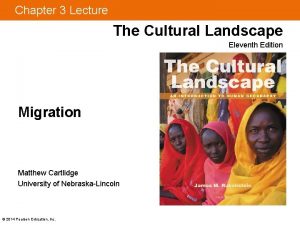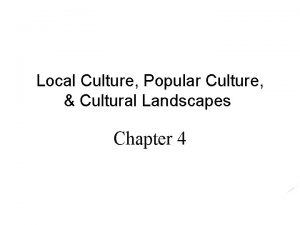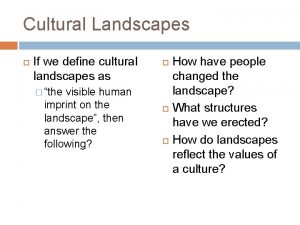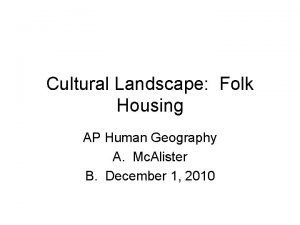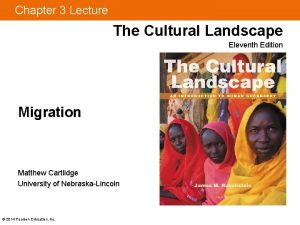Chapter 13 Lecture The Cultural Landscape Eleventh Edition














- Slides: 14

Chapter 13 Lecture The Cultural Landscape Eleventh Edition Urban Patterns Matthew Cartlidge University of Nebraska-Lincoln © 2014 Pearson Education, Inc.

Key Issues • Why do services cluster downtown? • Where are people distributed within urban areas? • Why are urban areas expanding? • Why do cities face challenges? © 2014 Pearson Education, Inc.

Learning Outcomes • 13. 4. 1: Describe the processes of deterioration and gentrification in cities. • 13. 4. 2: Explain the problems of a permanent underclass and culture of poverty in cities • 13. 4. 3: Describe the difficulties that cities face in paying for services, especially in a recession. © 2014 Pearson Education, Inc.

Why Do Cities Face Challenges? • Changing Urban Physical Geography – The Process of Deterioration • Filtering – Large houses in older neighborhoods are subdivided into smaller dwellings for low-income families, through a process known as filtering. – Over time, landlords cease maintaining the properties when they are no longer economically feasible. • Redlining – Some banks engage in redlining- drawing lines on a map to identify areas in which they will refuse to loan money to purchase or to fix up a house. – Redlining is illegal but difficult to enforce © 2014 Pearson Education, Inc.

Why Do Cities Face Challenges? • Changing Urban Physical Geography – The Process of Deterioration • Public Housing – During the mid-twentieth century, many substandard innercity houses were demolished and replaced with public housing- housing reserved for low-income households, who must pay 30 percent of their income for rent. – A housing authority, established by the local government, manages the buildings, and the federal government pays for all expenses not covered by rent. – Most of the high-rise public housing projects built in the U. S. and Europe at this time are now considered unsatisfactory for families with children. © 2014 Pearson Education, Inc.

Fig. 13 -41 © 2014 Pearson Education, Inc.

Why Do Cities Face Challenges? • Changing Urban Physical Geography – Gentrification • Gentrification is the process by which middle-class people move into deteriorated inner-city neighborhoods and renovate the housing. • Most U. S. cities have at least one substantially renovated inner-city neighborhood where middleclass people live. – Middle class-families attracted by some of the following: » Houses may have more architectural character than those in the suburbs. » Proximity to cultural and recreational activities » Commuting time reduced to CBD © 2014 Pearson Education, Inc.

Fig. 13 -42 © 2014 Pearson Education, Inc.

Why Do Cities Face Challenges? • Changing Urban Social Geography – Underclass • Inner-city residents are frequently referred to as permanent underclass, because they are trapped in an unending cycle of economic and social problems. • Suffers from relatively higher rates of unemployment, alcoholism, drug addiction, illiteracy, juvenile delinquency, and crime. • Children often attend deteriorated schools • Affordable housing is difficult to secure • Tend to ignore good learning habits, regular school attendance, and completion of homework; the tendencies needed to elevate one’s self out of the underclass. © 2014 Pearson Education, Inc.

Why Do Cities Face Challenges? • Changing Urban Social Geography – Culture of Poverty • Inner-city residents are trapped as a permanent underclass, because they live in a culture of poverty. • Characterized by: – Unwed mothers giving birth to ¾ of the babies in the U. S. inner-city neighborhoods – ¾ of children in the inner city live with only one parent – Relatively higher usage of drugs. © 2014 Pearson Education, Inc.

Why Do Cities Face Challenges? • Urban Economic Challenges – The Eroding Tax Base • Low-income inner-city residents require public services, but they pay little of the taxes needed to fund the public services. • Cities have two choices to close the gap between the cost of operating public services and the funding made available by taxing. 1. Reduce Services 2. Raise Tax Revenues © 2014 Pearson Education, Inc.

Why Do Cities Face Challenges? • Urban Economic Challenges – The Impact of the Recession • Housing market collapse in 2008 was one of principal causes of the severe recession. • Lower assessed values of houses led to lower tax revenues acquired from property taxes. • When borrowers cease paying their mortgages, lenders can take over the property in what is called a foreclosure. © 2014 Pearson Education, Inc.

Fig. 13 -47 © 2014 Pearson Education, Inc.

Summary • Services, especially public and business services, cluster in the CBD; some consumer services, especially leisure, are in the CBD. • Three models help to explain where different groups of people live within urban areas. • Urban growth has been primarily focused on suburbs that surround older cities. • Cities face physical, social, and economic difficulties, but some improvements also occurred. © 2014 Pearson Education, Inc.
 Eleventh edition management
Eleventh edition management Management eleventh edition stephen p robbins
Management eleventh edition stephen p robbins Management eleventh edition
Management eleventh edition Management eleventh edition stephen p robbins
Management eleventh edition stephen p robbins The cultural landscape chapter 3
The cultural landscape chapter 3 The cultural landscape chapter 3
The cultural landscape chapter 3 The cultural landscape chapter 3
The cultural landscape chapter 3 Chadha committee
Chadha committee Eleventh 5 year plan
Eleventh 5 year plan Thfive
Thfive For his eleventh birthday elvis presley
For his eleventh birthday elvis presley Cultural landscape convergence
Cultural landscape convergence What is the meaning of cultural landscape
What is the meaning of cultural landscape Fred kniffen ap human geography
Fred kniffen ap human geography Kurgan hypothesis
Kurgan hypothesis






